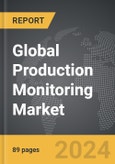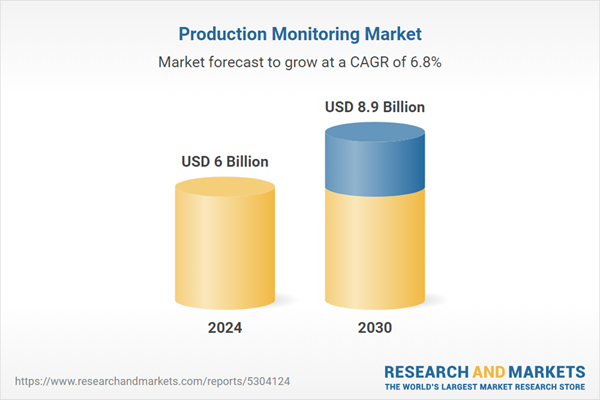Global Production Monitoring Market - Key Trends & Drivers Summarized
What is Production Monitoring, and Why is It Essential for Modern Manufacturing?
Production monitoring refers to the continuous tracking and assessment of manufacturing processes, enabling companies to ensure productivity, efficiency, and quality throughout their operations. By using production monitoring systems, manufacturers can gather real-time data on machine performance, labor efficiency, production rates, downtime, and defect rates. This data-driven approach provides a clear view of the production floor, allowing for proactive decision-making and timely adjustments to improve operational efficiency. Production monitoring is essential in industries like automotive, electronics, aerospace, and consumer goods, where quality, speed, and cost efficiency are critical to competitiveness. Through enhanced visibility into production performance, companies can minimize waste, optimize resource allocation, and reduce the likelihood of bottlenecks and delays.Beyond operational benefits, production monitoring plays a vital role in quality control and regulatory compliance. By continuously tracking production data, companies can ensure that products meet required specifications and industry standards, reducing the risk of defects and recalls. Moreover, production monitoring systems help companies stay compliant with increasingly stringent regulations by maintaining accurate records of production processes, quality inspections, and machine calibrations. This focus on continuous improvement aligns with lean manufacturing principles and supports a company’s ability to meet customer demands consistently. As a result, production monitoring has become an indispensable tool for companies aiming to maintain high standards and improve their bottom line in today’s competitive landscape.
How Are Technological Advancements Enhancing Production Monitoring?
Technological advancements in IoT, data analytics, and artificial intelligence (AI) have significantly transformed the production monitoring market, making it more efficient and accessible. IoT-enabled sensors and devices provide real-time data on machine status, energy usage, and environmental conditions, giving companies instant insight into every aspect of the production process. These sensors allow for continuous data collection without human intervention, increasing accuracy and enabling real-time visibility into equipment performance. When integrated with AI, production monitoring systems can identify patterns and predict equipment failures before they occur, supporting predictive maintenance strategies. This proactive approach to maintenance reduces downtime, extends equipment life, and minimizes repair costs, making production processes more resilient and reliable.Additionally, cloud-based platforms have made production monitoring systems more scalable and easier to implement across global operations. Cloud technology allows companies to centralize data from multiple production sites, providing a unified view of performance metrics across locations. With advanced analytics, companies can quickly analyze data trends, track KPIs, and identify areas for improvement, all from a single dashboard. Machine learning algorithms enhance these insights by identifying hidden patterns and optimizing production parameters, enabling companies to adjust processes in real time. Furthermore, digital twins - virtual replicas of physical production systems - are increasingly used in conjunction with production monitoring to simulate different scenarios, test production changes, and prevent potential issues. These technologies make production monitoring a more powerful tool, enabling companies to stay agile, make data-driven decisions, and continuously improve operational efficiency.
Why Are Companies Adopting Production Monitoring Solutions?
Companies are adopting production monitoring solutions to gain real-time visibility into their manufacturing operations, improve productivity, and reduce costs. As global competition intensifies, manufacturers are under pressure to optimize every aspect of their production processes to remain competitive. Production monitoring provides valuable insights into machine performance, production flow, and workforce productivity, enabling managers to identify inefficiencies and address them promptly. For instance, by monitoring equipment usage and cycle times, companies can minimize idle time, balance workloads, and increase overall production output. This focus on operational efficiency helps companies achieve higher production volumes without significant increases in labor or material costs.Production monitoring is also essential for quality assurance, helping companies maintain consistency and reduce defect rates. By capturing real-time data on production variables, such as temperature, pressure, and speed, companies can ensure that products meet specifications and avoid costly recalls or rework. For industries with stringent quality standards, such as automotive and aerospace, production monitoring provides critical oversight to ensure compliance and maintain customer satisfaction. Additionally, production monitoring supports continuous improvement initiatives by allowing companies to set benchmarks, track progress, and evaluate the effectiveness of process changes. This data-driven approach to production not only improves quality and efficiency but also empowers companies to respond to market demands more flexibly and sustainably.
What Factors Drive Growth in the Production Monitoring Market?
The growth of the production monitoring market is driven by several key factors, including digital transformation, the need for operational efficiency, and increasing focus on quality management. As manufacturers embrace Industry 4.0 and digital transformation, the adoption of production monitoring solutions has accelerated, as companies recognize the value of real-time data and analytics in optimizing operations. With the proliferation of IoT devices, cloud computing, and data integration platforms, production monitoring systems have become more accessible, allowing companies of all sizes to implement advanced monitoring and control systems. The need for operational efficiency is another significant growth driver, as companies strive to minimize waste, maximize resource utilization, and reduce downtime to maintain profitability.Moreover, the increasing demand for high-quality products and regulatory compliance across industries has heightened the importance of production monitoring. Consumers and regulators are placing greater emphasis on product quality and safety, making production monitoring an essential tool for maintaining standards and ensuring transparency in manufacturing processes. Additionally, the trend toward sustainable manufacturing is driving companies to adopt production monitoring systems that allow them to track resource consumption, energy usage, and waste production, aligning with corporate social responsibility (CSR) and environmental, social, and governance (ESG) goals. These factors - digital transformation, operational efficiency, quality assurance, and sustainability - are collectively fueling the growth of the production monitoring market, as companies seek to enhance productivity, reduce costs, and build a more sustainable manufacturing ecosystem.
Report Scope
The report analyzes the Production Monitoring market, presented in terms of units. The analysis covers the key segments and geographic regions outlined below.Segments: Component (Solutions, Services); Application (Business Process Optimization, Logistics & Supply Chain Management, Automation & Control Management, Emergency & Incident Management); Industry (Discrete Manufacturing, Process Manufacturing).
Geographic Regions/Countries: World; United States; Canada; Japan; China; Europe (France; Germany; Italy; United Kingdom; Spain; Russia; and Rest of Europe); Asia-Pacific (Australia; India; South Korea; and Rest of Asia-Pacific); Latin America (Argentina; Brazil; Mexico; and Rest of Latin America); Middle East (Iran; Israel; Saudi Arabia; United Arab Emirates; and Rest of Middle East); and Africa.
Key Insights:
- Market Growth: Understand the significant growth trajectory of the Solutions segment, which is expected to reach US$5.5 Billion by 2030 with a CAGR of a 6.5%. The Services segment is also set to grow at 7.3% CAGR over the analysis period.
- Regional Analysis: Gain insights into the U.S. market, valued at $1.6 Billion in 2024, and China, forecasted to grow at an impressive 10.9% CAGR to reach $2.0 Billion by 2030. Discover growth trends in other key regions, including Japan, Canada, Germany, and the Asia-Pacific.
Why You Should Buy This Report:
- Detailed Market Analysis: Access a thorough analysis of the Global Production Monitoring Market, covering all major geographic regions and market segments.
- Competitive Insights: Get an overview of the competitive landscape, including the market presence of major players across different geographies.
- Future Trends and Drivers: Understand the key trends and drivers shaping the future of the Global Production Monitoring Market.
- Actionable Insights: Benefit from actionable insights that can help you identify new revenue opportunities and make strategic business decisions.
Key Questions Answered:
- How is the Global Production Monitoring Market expected to evolve by 2030?
- What are the main drivers and restraints affecting the market?
- Which market segments will grow the most over the forecast period?
- How will market shares for different regions and segments change by 2030?
- Who are the leading players in the market, and what are their prospects?
Report Features:
- Comprehensive Market Data: Independent analysis of annual sales and market forecasts in US$ Million from 2024 to 2030.
- In-Depth Regional Analysis: Detailed insights into key markets, including the U.S., China, Japan, Canada, Europe, Asia-Pacific, Latin America, Middle East, and Africa.
- Company Profiles: Coverage of players such as Aspen Technology, Cannon Automata, Capgemini, Coesia, Emerson and more.
- Complimentary Updates: Receive free report updates for one year to keep you informed of the latest market developments.
Some of the 33 companies featured in this Production Monitoring market report include:
- Aspen Technology
- Cannon Automata
- Capgemini
- Coesia
- Emerson
- Hitachi
- Infinity Qs
- Infosys
- Intouch Monitoring
- IQMS
- Lineview
- Monnit
- Oracle
- Ordinal Software
- PCE Instruments
- Petrodaq
- Rockwell Automation
- RT Engineering
- Schlumberger
- Sedapta
- Siemens
- Softweb Solutions
- Tesar
- Verizon
- Vertech
Tariff Impact Analysis: Key Insights for 2025
Global tariff negotiations across 180+ countries are reshaping supply chains, costs, and competitiveness. This report reflects the latest developments as of April 2025 and incorporates forward-looking insights into the market outlook.The analysts continuously track trade developments worldwide, drawing insights from leading global economists and over 200 industry and policy institutions, including think tanks, trade organizations, and national economic advisory bodies. This intelligence is integrated into forecasting models to provide timely, data-driven analysis of emerging risks and opportunities.
What’s Included in This Edition:
- Tariff-adjusted market forecasts by region and segment
- Analysis of cost and supply chain implications by sourcing and trade exposure
- Strategic insights into geographic shifts
Buyers receive a free July 2025 update with:
- Finalized tariff impacts and new trade agreement effects
- Updated projections reflecting global sourcing and cost shifts
- Expanded country-specific coverage across the industry
Table of Contents
Companies Mentioned (Partial List)
A selection of companies mentioned in this report includes, but is not limited to:
- Aspen Technology
- Cannon Automata
- Capgemini
- Coesia
- Emerson
- Hitachi
- Infinity Qs
- Infosys
- Intouch Monitoring
- IQMS
- Lineview
- Monnit
- Oracle
- Ordinal Software
- PCE Instruments
- Petrodaq
- Rockwell Automation
- RT Engineering
- Schlumberger
- Sedapta
- Siemens
- Softweb Solutions
- Tesar
- Verizon
- Vertech
Table Information
| Report Attribute | Details |
|---|---|
| No. of Pages | 89 |
| Published | April 2025 |
| Forecast Period | 2024 - 2030 |
| Estimated Market Value ( USD | $ 6 Billion |
| Forecasted Market Value ( USD | $ 8.9 Billion |
| Compound Annual Growth Rate | 6.8% |
| Regions Covered | Global |









